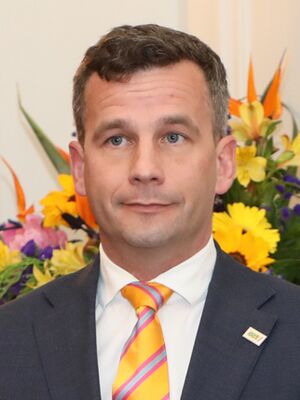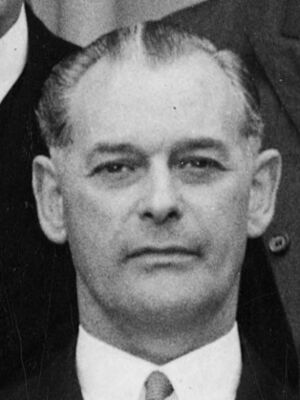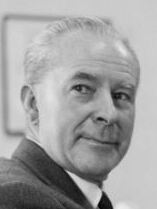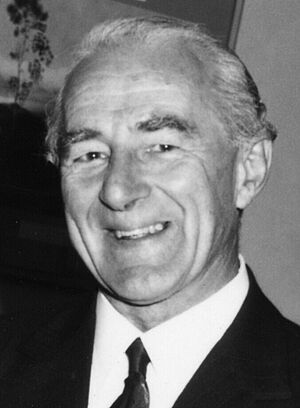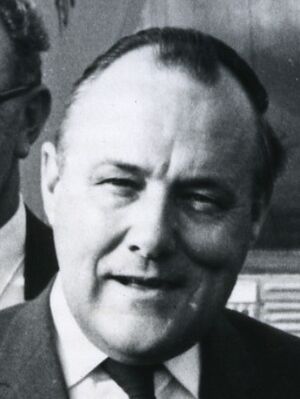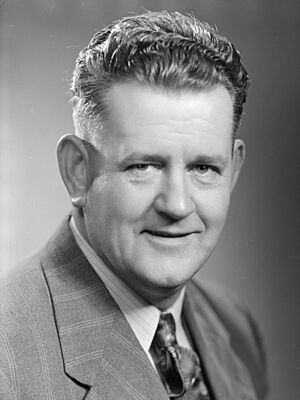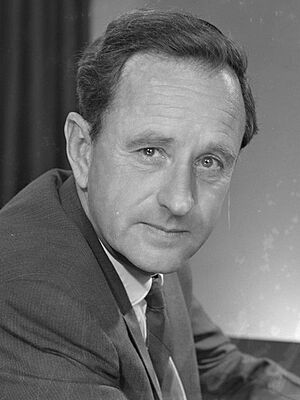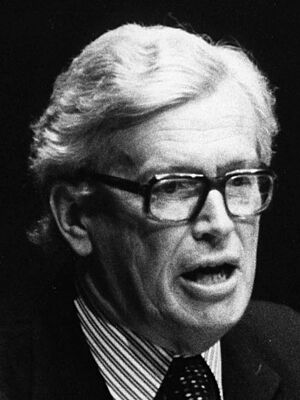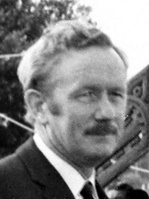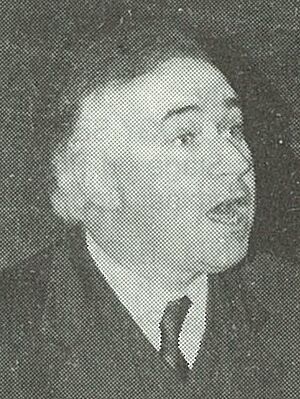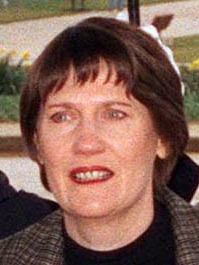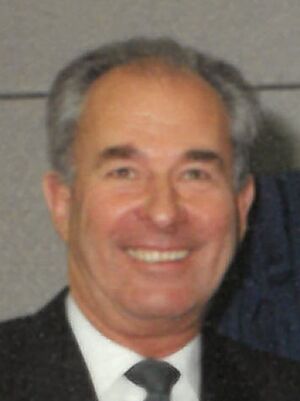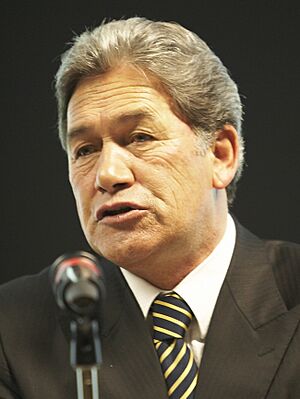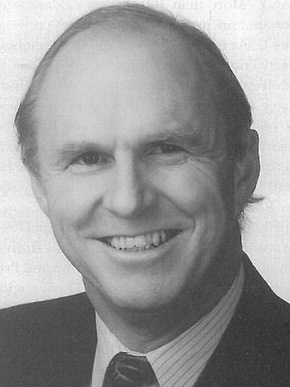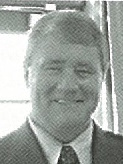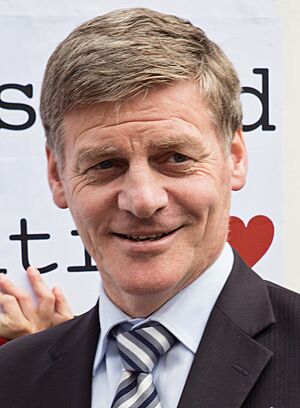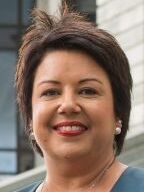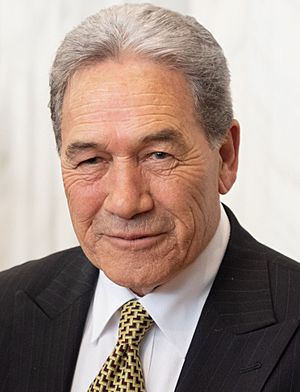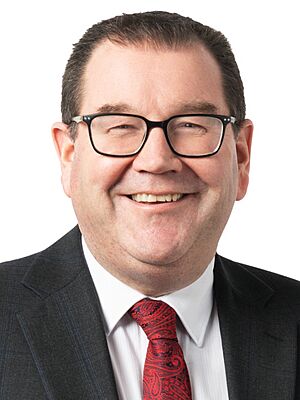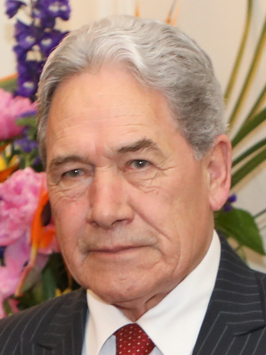Deputy Prime Minister of New Zealand facts for kids
Quick facts for kids Deputy Prime Minister ofNew Zealand |
|
|---|---|

|
|

|
|
| Department of the Prime Minister and Cabinet | |
| Style |
|
| Member of |
|
| Reports to | Prime Minister of New Zealand |
| Appointer | Governor-General of New Zealand |
| Term length | No fixed term |
| Formation | 13 December 1949 |
| First holder | Keith Holyoake |
| Salary | NZ$354,100 annually |
The Deputy Prime Minister of New Zealand (in Māori: Māori: Te pirimia tuarua o Aotearoa) is the second most important person in the Cabinet of New Zealand. The Cabinet is a group of top government ministers who make important decisions for the country. The Deputy Prime Minister often steps in for the Prime Minister at official events.
Since May 31, 2025, the current Deputy Prime Minister is David Seymour from the ACT Party. This role has existed informally for a long time. However, it became an official government job in 1949. This means Keith Holyoake was the first official Deputy Prime Minister. In 1954, it became a full position within the Cabinet.
Contents
What the Deputy Prime Minister Does
The job of Deputy Prime Minister was officially created in 1949. Since then, 18 different people have held this position. Some people have even held it more than once! Several Deputy Prime Ministers later became the Prime Minister. These include Keith Holyoake, Jack Marshall, Hugh Watt, Robert Muldoon, Geoffrey Palmer, Helen Clark, and Bill English.
The Deputy Prime Minister is always a member of the Cabinet. They also always have at least one other important job in the government.
Helping the Prime Minister
The Deputy Prime Minister can take over the Prime Minister's duties if the Prime Minister is not available or cannot do their job. They can also act as the acting prime minister if needed. This is usually done after talking with the Prime Minister. If something serious happens, like the Prime Minister passing away, the Deputy Prime Minister can temporarily lead the government. They stay in charge until a new leader is chosen.
How the Deputy Prime Minister is Chosen
In the past, the Deputy Prime Minister was usually the second-in-command of the biggest political party. However, since New Zealand started using a new voting system called MMP in 1996, things have changed. Now, New Zealand often has coalition governments. This means different parties work together to form the government.
Because of this, the Deputy Prime Minister role can now go to the leader of a smaller party in the government. This has happened three times with Winston Peters, who leads New Zealand First. It also happened with Jim Anderton, leader of the Alliance, and with David Seymour, leader of ACT New Zealand. Sometimes, the Labour Party has chosen a senior minister who was not their party's deputy leader for the role. This happened with Grant Robertson and Carmel Sepuloni.
Past Deputy Prime Ministers of New Zealand
Here is a list of the people who have served as Deputy Prime Minister of New Zealand. The colors show which political party they belonged to.
- Key
Alliance Labour National NZ First ACT
| No. | Portrait | Name | Term of office | Other government jobs | Prime Minister | |||
|---|---|---|---|---|---|---|---|---|
| 1 | Keith Holyoake MP for Pahiatua (1904–1983) |
13 December 1949 | 20 September 1957 |
|
Holland | |||
| 2 | Jack Marshall MP for Karori (1912–1988) |
20 September 1957 | 12 December 1957 |
|
Holyoake | |||
| 3 | Jerry Skinner MP for Buller (1900–1962) |
12 December 1957 | 12 December 1960 |
|
Nash | |||
| (2) | Jack Marshall MP for Karori (1912–1988) |
12 December 1960 | 9 February 1972 |
|
Holyoake | |||
| 4 | Robert Muldoon MP for Tamaki (1921–1992) |
9 February 1972 | 8 December 1972 | Marshall | ||||
| 5 | Hugh Watt MP for Onehunga (1912–1980) |
8 December 1972 | 1 September 1974 |
|
Kirk | |||
| 6 | Bob Tizard MP for Otahuhu (1924–2016) |
10 September 1974 | 12 December 1975 | Rowling | ||||
| 7 | Brian Talboys MP for Wallace (1921–2012) |
12 December 1975 | 4 March 1981 |
|
Muldoon | |||
| 8 | Duncan MacIntyre MP for East Cape (1915–2001) |
4 March 1981 | 15 March 1984 |
|
||||
| 9 | Jim McLay MP for Birkenhead (born 1945) |
15 March 1984 | 26 July 1984 |
|
||||
| 10 | Geoffrey Palmer MP for Christchurch Central (born 1942) |
26 July 1984 | 8 August 1989 |
|
Lange | |||
| 11 | Helen Clark MP for Mount Albert (born 1950) |
8 August 1989 | 2 November 1990 |
|
Palmer | |||
| Moore | ||||||||
| 12 | Don McKinnon MP for Albany (born 1939) |
2 November 1990 | 16 December 1996 |
|
Bolger | |||
| 13 | Winston Peters MP for Tauranga (born 1945) |
16 December 1996 | 14 August 1998 | |||||
| Shipley | ||||||||
| 14 | Wyatt Creech MP for Wairarapa (born 1946) |
14 August 1998 | 10 December 1999 |
|
||||
| 15 | Jim Anderton MP for Wigram (1938–2018) |
10 December 1999 | 15 August 2002 |
|
Clark | |||
| 16 | Michael Cullen List MP (1945–2021) |
15 August 2002 | 19 November 2008 |
|
||||
| 17 | Bill English MP for Clutha-Southland (until 2014) List MP (from 2014) (born 1961) |
19 November 2008 | 12 December 2016 |
|
Key | |||
| 18 | Paula Bennett MP for Upper Harbour (born 1969) |
12 December 2016 | 26 October 2017 |
|
English | |||
| (13) | Winston Peters List MP (born 1945) |
26 October 2017 | 6 November 2020 |
|
Ardern | |||
| 19 | Grant Robertson MP for Wellington Central (born 1971) |
6 November 2020 | 25 January 2023 |
|
||||
| 20 | Carmel Sepuloni MP for Kelston (born 1977) |
25 January 2023 | 27 November 2023 |
|
Hipkins | |||
| (13) | Winston Peters List MP (born 1945) |
27 November 2023 | 31 May 2025 |
|
Luxon | |||
| 21 | David Seymour MP for Epsom (born 1983) |
31 May 2025 | Incumbent |
|
||||
Timeline of Deputy Prime Ministers
This timeline shows when each person served as Deputy Prime Minister and which political party they belonged to.



